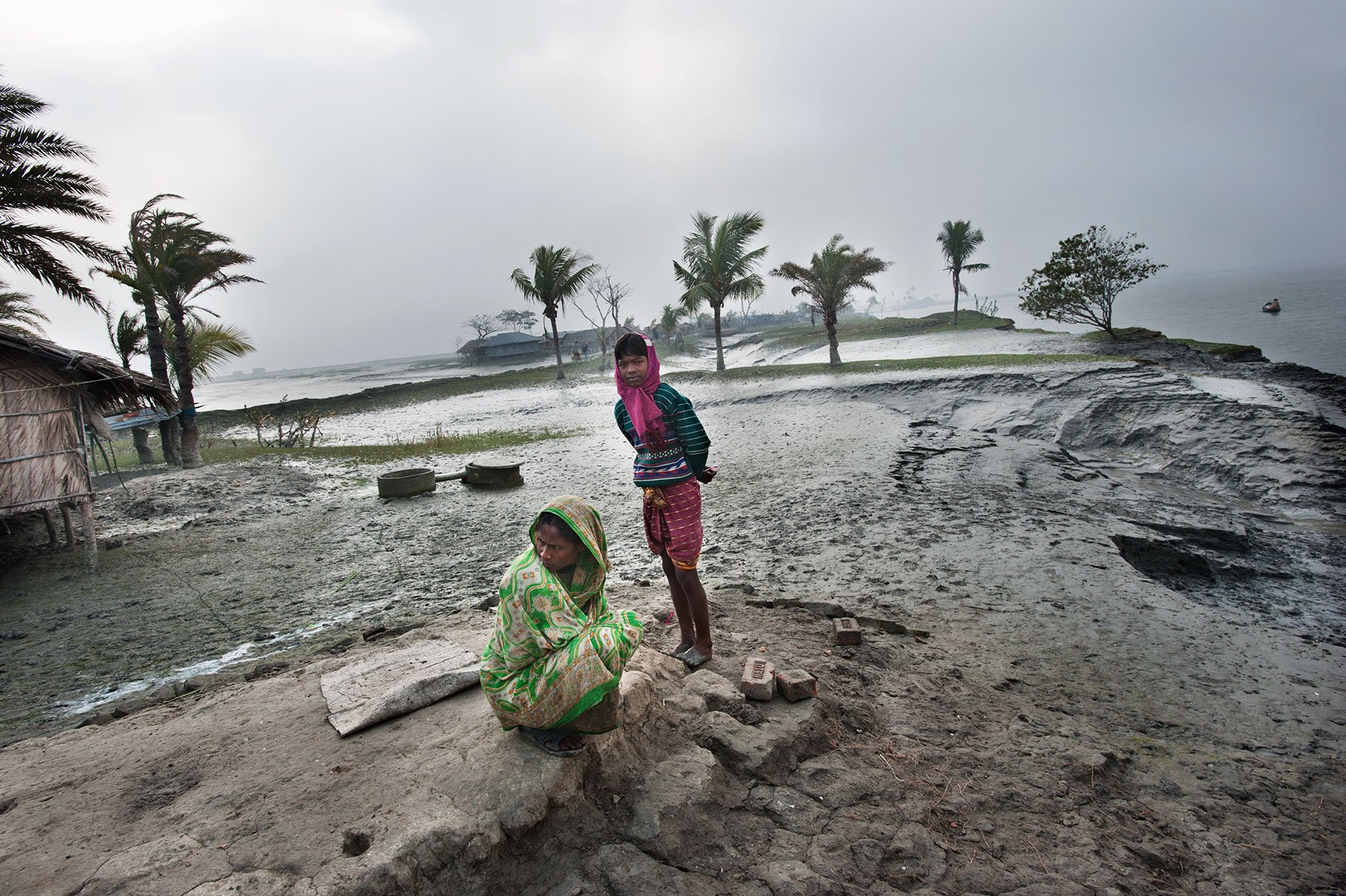NYC: Rising Tide: a small exhibit with a big message
A mother and daughter in Bainpara, Bangladesh. Some houses remain, but most were swallowed by Cyclone Alia in May 2009. Photo by Kadir van Lohuizen / NOOR
By Madeleine Traynor (MA ’22)
It was a gray, soggy, and unseasonably warm March morning in Manhattan.
As I walked up the slick stone steps of the Museum of the City of New York, located in East Harlem, I noticed there was no line to wait in — there wasn’t anyone else around. The entrance was quiet. A sole security guard greeted me and asked for my vaccination record. I followed the tiles directing me through the gift shop, where I bought a $20 pass and pasted a small black admissions sticker to the front of my sweater.
I came to see the Rising Tide exhibit, open through May 1, by the Dutch photographer and filmmaker Kadir van Lohuizen. The premise of the exhibit was to place New York City within the broader context of the global climate crisis. Using a mix of still and live-action visuals paired with audio reels, it aims to take the audience around the world. Connecting visitors to the depth of the crisis on multiple sensory levels, the exhibit gives them a better understanding and, according to the artist, a realization that “there is no time to waste.”
When I entered the exhibit, I couldn't help but feel that it was much smaller than I expected. And yet at the same time, it didn't surprise me. Our collective response to the climate crisis has been muted, so much smaller and weaker than it needs to be. Perhaps this is the budding pessimist in me speaking, but it made sense that the space dedicated to a climate exhibit would be just as underwhelming.
However, the depth of the displays, the global scope, and the humanity of the content drew me in — I was impressed.
Eerie music played over the footage of glaciers as the sound of water rapids running deep from melt sloshed in the background. Images of the desolate landscape left behind flashed across the screen.
The maps of Greenland’s ice mass lost from 2007 to 2016 were alarming. I thought about how 2007 wasn’t that long ago and wondered what this map will look like with 10 more years of melt, or even what it already looks like now.
Across the room, the sounds from a longer film playing on repeat to 24 empty seats reverberated across the four walls. The noise of city sirens blared as the film explained that an estimated seven million people have already been displaced in Bangladesh and another 50 million may soon follow.
The film panned to Kiribati. Shouts from children playing on a beach echoed while the film explained that much of the island will be underwater within decades. The text read, “if your land disappears, who are you?”
Across the world, we were taken to a paradox of wealth: yachts, new construction, and mansions. “Miami, the most endangered city in the U.S.,” rolled across the screen.
New York, Papua New Guinea, Boston, the Netherlands. The film quickly traversed the globe, highlighting the disparities in both wealth and the responses to rising seas.
For a small exhibit, it certainly elicits emotion. Fear, sadness, perhaps even nostalgia for a time that didn’t feel quite so dire.
But, like any good climate communication, it also attempts to inspire action. Leaving the visitors with paper placards they can take home as commitments and reminders to what they have learned and what they hope to change in their own lives. I couldn’t help but think that a small piece of paper that reads, “waste less food!” or “skip the rush shipping!” stuck to your fridge was unlikely to get us collectively below 1.5 degrees of additional warming. But I suppose it is better than nothing.
In the hour I spent circumnavigating the medium-sized, one-room exhibit, there were very few people that came in. A father with a baby briefly perused the display on New York City’s climate commitments. Three young friends watched half of the video on the rapidly melting Greenland ice sheet. And one middle-aged couple sat down to watch the longer video on global sea level rise.
At first, I was disappointed. On this 70-degree day in early March where the weather forecast seemed to be shouting “climate change is real!” I hoped there would be more people here.
This exhibit has been open for months, so I wondered if most people had already come and gone. Or maybe I had just come at the wrong time of day. Or perhaps, it was that we have collectively been moving through a global pandemic for two years, a war is raging across the Atlantic, our domestic politics are more divided than ever, and maybe what people needed on that rainy Sunday morning was not more bad news.
Madeleine Traynor is a graduate student in the M.A. in climate and society program at the Columbia Climate School. Her background is in land-based regenerative agriculture and nonprofit communications.

